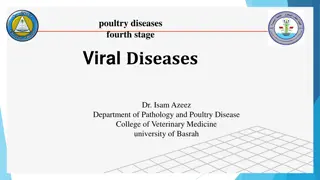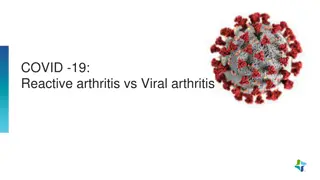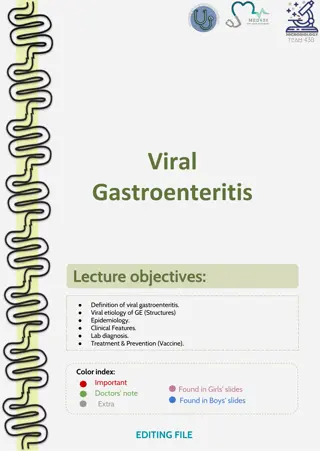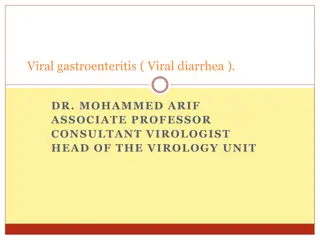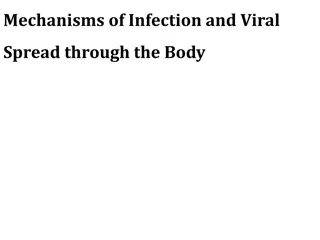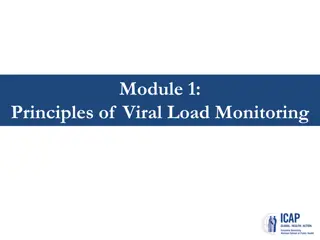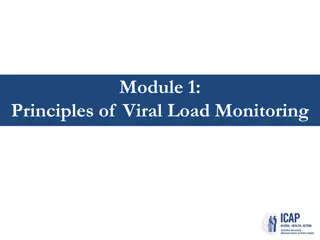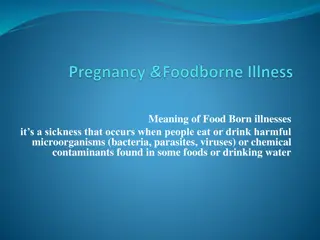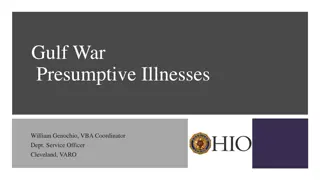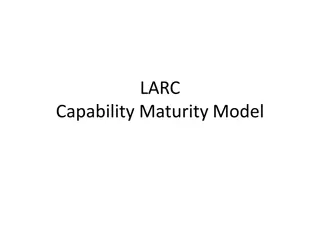Understanding Viral Vectors in Gene Delivery: Safety and Considerations
Exploring the mechanisms of gene delivery via viral vectors, this content delves into the basics of viral structure, infection, and replication. It discusses common viral vector systems like Adenoviral and Lentiviral vectors, highlighting safety considerations and the production processes involved.
1 views • 19 slides
Understanding Viral Pathogenesis: Insights into Disease Development
Viral pathogenesis explores the intricate relationship between viruses and their hosts, encompassing factors like viral effects on cells, entry mechanisms, tissue tropism, immune responses, and the outcomes of infection. This process involves a series of interactions leading to either virus clearanc
1 views • 29 slides
A Scientific Approach to Pandemic Preparedness
Barney S. Graham, MD, PhD, outlines a scientific framework for epidemic and pandemic research preparedness to achieve fast and equitable access to high-quality vaccines for future pandemics. The discussion covers new human viral pathogens, 21st-century viral threats, viral taxonomy, and a prototype
0 views • 16 slides
Understanding Viral Diseases in Poultry: Newcastle Disease and Avian Influenza
Viral diseases like Newcastle Disease (ND) and Avian Influenza (AI) pose significant threats to poultry farming, impacting bird health and production. ND, caused by Avian paramyxovirus type 1, is highly contagious and manifests in various forms affecting birds' respiratory and nervous systems. On th
7 views • 24 slides
Uptake of Viral Load Testing and Viraemic Episodes During Pregnancy in Johannesburg, South Africa
This study investigates the uptake of viral load testing and frequency of viraemic episodes during pregnancy among HIV-positive mothers in Johannesburg, South Africa. Data from a cohort of mothers and infants born at a local hospital were linked to laboratory data for analysis. The results show the
2 views • 12 slides
Understanding COVID-19's Impact on Joint Health: Reactive Arthritis vs Viral Arthritis
Explore the distinction between reactive arthritis and viral arthritis in the context of COVID-19, discussing symptoms, triggers, and potential long-term consequences on joint health. Learn how viral infections can lead to acute arthralgia and arthritis, including common pathogens such as Hepatitis
0 views • 30 slides
Understanding Common Illnesses and Health Advice
Explore various common illnesses like flu, fever, headache, cold, and their symptoms through images. Learn how to describe illnesses using verbs and match symptoms with the right illness. Additionally, discover health advice using "should" and "shouldn't" with appropriate illnesses.
1 views • 18 slides
The Transmission and Movement of Plant Viruses
Plant viruses are transmitted through various means such as cell-to-cell movement via plasmodesmata and systemic spread through vascular tissues. The viral proteins and mechanisms facilitating these movements are crucial for viral infection and spread within plant hosts. Understanding the different
0 views • 47 slides
Virus Entry Mechanisms: Understanding Pathogenesis and Spread
Exploring the diverse ways viruses enter the body through various routes such as respiratory tract, oropharynx, skin, genitourinary tract, and eyes, shedding light on the steps of the virus life cycle shaping pathogenesis. Viral diseases result from the intricate interaction between viral and host f
4 views • 20 slides
Viral Genome Replication Strategies and Mechanisms
Viruses utilize different replication strategies to ensure the replication of viral genomes, packaging into virions, and potentially altering the host cell's structure or function. These strategies are vital for the virus to operate effectively within the host cell's constraints. The replication pro
0 views • 15 slides
Overview of Viral Gastroenteritis: Etiology, Epidemiology, Clinical Features, Diagnosis, and Treatment
Viral gastroenteritis is an inflammation of the gastrointestinal tract primarily affecting the stomach and small intestine, leading to symptoms like acute diarrhea and vomiting. It can be caused by various infectious agents such as Rotavirus, Adenovirus, Caliciviruses, Astrovirus, Coronavirus, Torov
1 views • 7 slides
Capability Maturity Model Cascade and Viral Load Testing Stages
This content discusses the Capability Maturity Model stages, focusing on process improvement and the stages of viral load testing demand creation. It outlines the evolution from initial to optimized stages and the development towards standardized processes in organizations. Additionally, it touches
3 views • 8 slides
Viral Specimen Selection and Collection Overview
Specimen selection for viral testing depends on the suspected viral etiologies and disease syndrome. Throat and nasopharyngeal swabs are used for different viruses, while rectal swabs, urine, blood, and tissue samples are also collected for specific viral detection. Proper specimen transport and sto
0 views • 7 slides
Understanding Viral Gastroenteritis: Causes, Symptoms, and Transmission
Viral gastroenteritis, commonly known as viral diarrhea, is a prevalent infection affecting mainly infants and young children. The disease is self-limiting, with symptoms like diarrhea, vomiting, and abdominal pain. Key viral etiologies include Rota viruses, Astroviruses, Norovirus, and Enteric aden
0 views • 19 slides
Extreme Heat Preparedness and Impacts: CERT Hazard Annexes
Introduction to CERT Hazard Annexes focusing on extreme heat, discussing heat-related illnesses, impacts of extreme heat, and preparedness measures including insulation, window protection, and attic fans. The content emphasizes the preventable nature of heat-related illnesses and the vulnerabilities
0 views • 26 slides
National Viral Hepatitis Control Program - Achieving Universal Health Coverage and Elimination Goals
The National Viral Hepatitis Control Program in India is working towards combating viral hepatitis and achieving SDG goal 3.3 through a comprehensive approach that includes awareness generation, prevention, management, and financing under the NHM. The aim is to eliminate hepatitis C by 2030, reduce
0 views • 19 slides
Understanding Foodborne Illness: Causes and Symptoms
Foodborne illnesses are diseases transmitted to humans through contaminated food, causing symptoms like nausea, vomiting, stomach cramps, fever, and diarrhea. These illnesses are mainly caused by pathogenic microorganisms such as bacteria, viruses, and parasites, often spread through mishandling of
0 views • 10 slides
Understanding Severe Mental Illness in Mothers: Impacts and Support
Mothers with severe mental illnesses like Schizophrenia face unique challenges in parenting. Support from partners, family, and the community is crucial for their well-being. Despite the difficulties, with proper treatment and support, women with severe mental illnesses can effectively fulfill their
3 views • 23 slides
Zimbabwe Viral Load Clinic: Laboratory Interface Learning Session and Country Context Update
Zimbabwe hosted a vital learning session on viral load clinic laboratory interfaces and the epidemiology of HIV in the country. The session aimed to sensitize participants on the VL CLI, introduce the LARC team, and identify gaps in managing clients on ART with high viral loads. The country context
0 views • 18 slides
Viralizing YouTube Videos: Key Insights and Strategies
YouTube, a giant in user-generated video content, offers immense potential for videos to go viral. Understanding the dynamics of viralization on YouTube is crucial for content creators. This chapter delves into the phenomena of viral videos on YouTube, explores key factors that contribute to a video
0 views • 42 slides
Understanding Mechanisms of Viral Infection and Spread
Viral infection involves a replicative cycle within the host, leading to a range of cellular responses from no apparent effect to disease. Factors such as virulence genes, host characteristics, and viral genome influence the pathogenicity and virulence of a virus. The process includes entry into the
0 views • 16 slides
Understanding HIV: Transmission, Symptoms, and Management
HIV, a single-stranded, positive-sense, enveloped RNA retrovirus, is transmitted through various means such as sexual intercourse, vertical transmission, and blood contact. The virus targets T cells, macrophages, and other immune cells, leading to acute and chronic stages with distinct symptoms. As
0 views • 37 slides
Food Safety and Prevention of Food-borne Illnesses
An estimated 48 million Americans suffer from food-borne illnesses yearly, caused by harmful microorganisms due to poor food handling practices. Factors contributing to food-borne illnesses include improper cooking, inadequate storage, and cross-contamination. To prevent such illnesses, it is essent
0 views • 23 slides
Zimbabwe HIV Viral Load Testing Overview
Zimbabwe's plan to scale up HIV viral load testing from 2018 to 2020 is outlined, with targets set for each year. The country has made significant progress in expanding its viral load testing capacity, going from targeted testing to near-universal coverage by 2018. Various testing laboratories in Zi
0 views • 9 slides
Principles of Viral Load Monitoring in HIV Infection
Understanding viral load dynamics in HIV infection is crucial for managing treatment and transmission risks. Viral load monitoring helps assess response to antiretroviral therapy and identify treatment failure. Regular viral load testing is recommended for both adults and children on ART, allowing f
0 views • 40 slides
Principles of Viral Load Monitoring in HIV Patients
Explore the dynamics of viral load in HIV infection, its impact on transmission and disease progression, response to antiretroviral therapy, identification of treatment failure, and monitoring schedules. Understand the significance of viral load testing in managing HIV patients effectively.
0 views • 47 slides
- Risks of Foodborne Illnesses During Pregnancy
- Pregnant women are at high risk of foodborne illnesses due to weakened immune systems. Such illnesses can lead to serious health issues for both mother and fetus, including miscarriage and premature delivery. Symptoms may include stomach-related discomfort, vomiting, and diarrhea. Immediate medica
0 views • 15 slides
Gulf War Presumptive Illnesses and Eligibility Requirements for Veterans
Gulf War Veterans who served in the Southwest Asia theater of military operations may be entitled to disability compensation for certain undiagnosed illnesses, chronic disability patterns, and presumptive diseases. Eligible Veterans can receive a free Gulf War Registry health exam to identify potent
2 views • 18 slides
Gulf War Veterans Disability Compensation Guide
Qualifying Gulf War veterans may be entitled to disability compensation for certain undiagnosed illnesses, chronic disability patterns, and presumptive diseases. Eligibility requirements include meeting specific conditions related to service-related disabilities or illnesses. The disabilities must f
0 views • 12 slides
Understanding Viral Social Media Challenges and Making Informed Choices
Explore the prevalence and impact of viral social media challenges, reflect on why they become popular, and discuss the importance of making conscious decisions to participate or abstain. Delve into examples like the Paqui Challenge and the concept of trends going viral, highlighting the influence o
0 views • 16 slides
Understanding Determinants of Cell, Organ, and Tissue Tropism in Viral Pathogenesis
Cell, organ, and tissue tropism are crucial in viral pathogenesis, influenced by factors such as routes of entry and spread within the host, cell permissiveness, and immune responses. Viruses penetrate epithelial barriers through various mechanisms to establish infection, navigating specialized cell
0 views • 29 slides
Understanding Viral Infections of the Respiratory System
Respiratory viral infections are common and primarily caused by viruses, leading to morbidity and time off work. They can range from mild upper respiratory tract infections to severe lower respiratory tract infections like pneumonia. Various viruses like influenza, parainfluenza, respiratory syncyti
0 views • 23 slides
Understanding Infectious Diseases: Approach, Prevention, and Viral Agents
Infectious diseases play a significant role in public health, with a focus on antibiotic stewardship, community-acquired and healthcare-associated infections, as well as various bacterial, viral, fungal, and parasitic agents. Specific topics include the prevention of infectious diseases, with a deta
0 views • 18 slides
Understanding the LARC Capability Maturity Model for Organizational Improvement
The LARC Capability Maturity Model (CMM) focuses on enhancing the viral load cascade, aiming to achieve better patient outcomes and improve institutional capabilities for viral load scale-up. Developed by Carnegie-Mellon University Software Engineering Institute in 1987, the CMM provides a structure
0 views • 14 slides
Canine Meningoencephalitis Study: Pan-Viral PCR Analysis
Study focuses on Canine Meningoencephalitis of unknown etiology using Pan-Viral PCR to detect infectious agents in cerebrospinal fluid samples. The research aims to identify aberrant immune responses in dogs with MUE. Consensus degenerate primers are used to target viral families like Herpesviridae,
0 views • 13 slides
Exploring Viral Spread Through Mathematical Modeling
Guide providing insights into viral transmission and exponential growth through a mathematical model programmed in Google Sheets. Students explore the impact of reproduction numbers (R0) on viral spread and strategies for reducing transmission. The resource includes instructional strategies, discuss
0 views • 8 slides
Tuberculosis as a Risk Factor for Viral Non-Suppression in Patients Switched to Dolutegravir-Based Therapy
The study investigates the impact of incident tuberculosis on viral non-suppression among patients transitioning to Dolutegravir-based therapy in Zambia. It aims to identify factors associated with viral non-suppression and describe clinical outcomes in the context of tuberculosis occurrence. The re
0 views • 13 slides
Facial Paralysis in the Cold: Why Bell's Palsy Strikes in Winter - Dr Sharad ENT
Bell's palsy is a temporary facial paralysis affecting one side of the face, often linked to viral infections and stress. Cold exposure in winter is considered a possible trigger due to increased viral illnesses, reduced blood flow, and irritation of
1 views • 7 slides
Understanding Viral Pathogenesis: Causes and Consequences
Viral pathogenesis involves the process by which a virus leads to disease, exploring the interplay between viral and host factors. It encompasses the concepts of virulence, viral disease, and the effects on infected cells and the host's immune response. Changes within infected cells, including cell
0 views • 26 slides
Understanding Food Safety: Microorganisms, Illnesses, and Prevention
Explore the world of food safety through the lens of microorganisms, illnesses, and prevention methods. Learn about different types of bacteria that can cause foodborne illnesses, such as Clostridium Perfringens and Staphylococcus Aureus, and understand the distinction between food intoxication and
0 views • 12 slides



